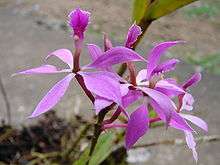Epidendrum flexuosum
Epidendrum flexuosum, a reed-stemmed Epidendrum common at mid-altitudes in Central America, is a species of orchid commonly called Epidendrum imatophyllum. It grows exposed to intense sunlight in the forest canopy,[1] particularly on Guava species. E. flexuosum bears non-resupinate lavender flowers on a congested raceme at the end of a long peduncle.
| Epidendrum flexuosum | |
|---|---|
 | |
| Scientific classification | |
| Kingdom: | |
| (unranked): | |
| (unranked): | |
| Order: | |
| Family: | |
| Subfamily: | |
| Tribe: | |
| Subtribe: | |
| Genus: | |
| Subgenus: | |
| Section: | |
| Subsection: | |
| Species: | E. flexuosum |
| Binomial name | |
| Epidendrum flexuosum G.Mey. | |
In the wild, Epidendrum flexuosum grows naturally together with a nest of ants,[2] and sometimes bees, wasps, or hornets,[3] which protect it from predators. This species is very difficult to grow without the ants, a phenomenon found in other genera such as Caularthron, Coryanthes, and Sievekingia.
Description
Epidendrum flexuosum has been placed in the subgenus E. subg. Amphiglottium[4] and shares the characteristics of that subgenus: it exhibits a sympodial growth habit with slender, unswollen stems covered by close distichous sheathes which are foliaceous on the upper sections of the stem; the inflorescence is terminal and covered from its base by distichous sheathes; and the lip is adnate to the column to its apex. The ligulate leaves have a small notch in the obtuse end.[5] The stem, including the peduncle, is flattened.[6] As is typical of the section E. sect. Schistochila, the inflorescence is a raceme, and the lip is lacerate. The lilac flowers are non-resupinate. The dorsal sepal is lanceolate and recurved, the lateral sepals are falcate, and the petals are rhombic[7] with lightly fringed to irregular margins. As is typical of the subsection E. subsect. Carinata, the lip is trilobate and has a keel, or carina, running down the center. In the case of E. flexuosum the lip is almost oval-shaped: Dodson & Bennett 1989 use the phrase "lip obscurely 3-lobed." The column is slightly s-shaped.
The chromosome number of an individual collected in Mamirauá, Brazil has been determined as 2n = 28[8]
Synonymy
List of synonyms:[9]
- E. buenavistae Kraenzl. (1908)
- E. imantophyllum Lindl. (1831)
- E. imatophyllum Hooker ex. Lindl (1831)[10]
- E. imetrophyllum Paxton (1837)
- E. lorifolium Schltr. (1922)
- E. palpigerum Rchb.f. (1879)
References
- as Epidendrum imatophyllum in Laube, Stefan; Zotz, Gerhard (2006). "Neither Host-specific nor Random: Vascular Epiphytes on Three Tree Species in a Panamanian Lowland Forest". Annals of Botany. 97 (6): 1103–1114. doi:10.1093/aob/mcl067. PMC 2803392. PMID 16574691.
- Alec M. Pridgeon, The Illustrated encyclopedia of orchids p. 121, Timber Press, 1992 – as Epidendrum imatophyllum Lindley
- The super-nettles. A dermatologist's guide to ants-in-the-plants in BoDD – Botanical Dermatology Database – as Epidendrum imatophyllum Lindley
- as E. imatophyllum with the notation "? Epidendrum flexuosum Meyer Fl. Essequeb. p. 260. LO. n. 34." H. G. Reichenbach "Orchides" nr. 277, C. Müller, Ed. Walpers. Annales Botanices Systematicae 6(1861) p. 391. Berlin.
- J. Lindley, "Epidendrum imatophyllum", pp. 106–107, No. 52. The Genera and Species of Orchidaceous Plants. Ridgeway, London. (1830–1840)
- C. Dodson & D. Bennett, "Epidendrum imatophyllum Lindl.", plate 0063 of Icones Plantarum Tropicarum, Series II: Orchids of Peru. Missouri Botanical Garden, St. Louis. 1989
- J. Lindley, "Epidendrum ? fexuosum", p. 103, No. 34. The Genera and Species of Orchidaceous Plants. Ridgeway, London. (1830–1840)
- Fábio Pinheiro, Samantha Koehler, Andréa Macêdo Corrêa, Maria Luiza Faria Salatino, Antonio Salatino & Fábio de Barros. "Phylogenetic relationships and infrageneric classification of Epidendrum subgenus Amphiglottium (Laeliinae, Orchidaceae)", Plant Systematics and Evolution published online 25 September 2009. Springer Wien. https://doi.org/10.1007%2Fs00606-009-0224-2
- "Epidendrum flexuosum G.Mey., Prim. Fl. Esseq.: 260 (1818): Synonyms". World Checklist of Selected Plant Families. Royal Botanic Gardens, Kew. Retrieved 21 May 2019.
- J. Lindley, "Epidendrum imatophyllum", pp. 106–107, No. 52. The Genera and Species of Orchidaceous Plants. Ridgeway, London. (1830–1840) available online at http://www.botanicus.org/title/b12026323
External links
Images in the wild (as E. imatophyllum): https://web.archive.org/web/20080308035848/http://www.abundaflora.com/epi_imat.htm